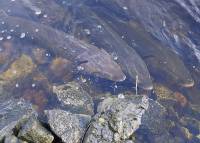 The lake sturgeon (Acipenser fulvescens) is a North American temperate freshwater fish, one of about 25 species of sturgeon. Like other sturgeons, this species is an evolutionarily ancient bottomfeeder with a partly cartilaginous skeleton, an overall streamlined shape and skin bearing rows of bony plates on its sides and back, resembling an armored torpedo. The fish uses its elongated, spadelike snout to stir up the substrate and sediments on the beds of rivers and lakes while feeding. The lake sturgeon has four purely sensory organs that dangle near its mouth. These organs, called barbels, help the sturgeon to locate bottom-dwelling prey.Lake sturgeons can grow to a relatively large size, topping six feet (two meters) long and weighing nearly 200 pounds (90 kilograms). Lake sturgeon are also extremely long-lived fish, males may live some 55 years, and female lake sturgeon can reach 150 years. This species occurs in the Mississippi River drainage basin south to Alabama and Mississippi. It occurs in the Great Lakes and east down the St. Lawrence River to the limits of fresh water. In the west it reaches Lake Winnipeg and the North and South Saskatchewan Rivers. In the north it is found in the Hudson Bay Lowland. This distribution makes sense in that all these areas were linked by the large lakes that formed as the glaciers retreated from North America at the end of the last ice age (e.g., Lake Agassiz, Lake Iroquois).
The lake sturgeon (Acipenser fulvescens) is a North American temperate freshwater fish, one of about 25 species of sturgeon. Like other sturgeons, this species is an evolutionarily ancient bottomfeeder with a partly cartilaginous skeleton, an overall streamlined shape and skin bearing rows of bony plates on its sides and back, resembling an armored torpedo. The fish uses its elongated, spadelike snout to stir up the substrate and sediments on the beds of rivers and lakes while feeding. The lake sturgeon has four purely sensory organs that dangle near its mouth. These organs, called barbels, help the sturgeon to locate bottom-dwelling prey.Lake sturgeons can grow to a relatively large size, topping six feet (two meters) long and weighing nearly 200 pounds (90 kilograms). Lake sturgeon are also extremely long-lived fish, males may live some 55 years, and female lake sturgeon can reach 150 years. This species occurs in the Mississippi River drainage basin south to Alabama and Mississippi. It occurs in the Great Lakes and east down the St. Lawrence River to the limits of fresh water. In the west it reaches Lake Winnipeg and the North and South Saskatchewan Rivers. In the north it is found in the Hudson Bay Lowland. This distribution makes sense in that all these areas were linked by the large lakes that formed as the glaciers retreated from North America at the end of the last ice age (e.g., Lake Agassiz, Lake Iroquois).
